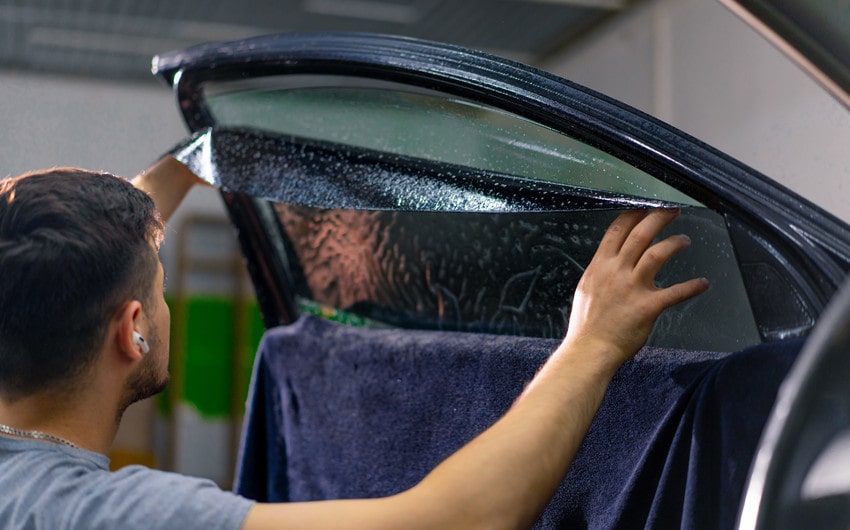Window tinting is a popular modification for vehicles, offering benefits like UV protection, privacy, and heat reduction. However, it is crucial to understand the legal regulations and safety concerns associated with window tinting.
Understanding Vehicle Window Tinting
Window tinting involves applying a thin film to a car’s windows to reduce the amount of visible light, UV rays, and heat that enter the vehicle. This modification is favored for various reasons, including enhanced privacy, interior protection, and improved comfort. Window tinting can be both a functional upgrade and an aesthetic enhancement for your vehicle.
Types of Window Tinting
There are several types of window tint films available, each with its own set of benefits and drawbacks:
- Dyed Tint: This is the most affordable option, using a layer of dye to block sunlight. It provides a dark appearance but can fade over time.
- Metalized Tint: This type of tint contains tiny metallic particles that reflect heat and UV rays. It is durable but can interfere with electronic signals.
- Carbon Tint: Carbon tints offer a matte finish and are effective at blocking UV rays and heat without signal interference.
- Ceramic Tint: The highest quality option, ceramic tints are non-conductive and block a significant amount of UV rays and heat while maintaining visibility.
Choosing the right type of tint depends on your budget, aesthetic preferences, and functional needs.
State Regulations on Window Tint Levels
Overview of Tint Laws
Window tint laws vary by state and are in place to ensure driver visibility and safety. These laws specify the allowable darkness of tint on front, rear, and side windows. Complying with local regulations is essential to avoid fines and penalties.
Tint Level Limits by State
Each state has different regulations regarding the permissible level of tint. Here is a summary of the allowable tint levels for the front side windows, rear side windows, and rear window in a few states:
- California: Front side windows must allow at least 70% of light in, while rear side windows and the rear window can have any darkness.
- Florida: Front side windows must allow at least 28% of light in, and rear side windows and the rear window must allow at least 15% of light in.
- New York: Front side windows must allow at least 70% of light in, and rear side windows and the rear window must allow at least 70% of light in.
- Texas: Front side windows must allow at least 25% of light in, and rear side windows and the rear window can have any darkness.
It’s important to check your state’s specific regulations to ensure compliance. Reliable sources for verifying up-to-date tint laws include state DMV websites and tint law databases.
Potential Encounters with Police
Reasons for Being Pulled Over
Police officers may pull over vehicles for window tint violations if the tint appears to be darker than allowed by law. Other common reasons include obstructed visibility of the driver or interior and safety concerns. Non-compliant tint levels can lead to legal implications, including fines and mandatory removal of the tint.
How to Handle a Traffic Stop
If you are pulled over for a window tint violation, it’s important to remain calm and respectful. Provide the officer with your driver’s license, registration, and proof of insurance when asked. Be prepared to explain any medical exemptions if applicable. Potential consequences of tint violations can include warnings, fines, and in some cases, an order to remove the tint and pass a follow-up inspection.
Safety Concerns: Visibility and Night Driving
Reduced Visibility Risks
One of the primary safety concerns with window tinting is reduced visibility, especially at night. Dark window tints can impair your ability to see pedestrians, cyclists, and other vehicles, increasing the risk of accidents.
Balancing Tint Levels and Safety
When choosing a tint level, it’s essential to balance the benefits of tinting with safety considerations. Opt for a tint that provides UV protection and heat reduction without significantly compromising your visibility. Consider factors such as nighttime driving and poor weather conditions when selecting a tint level. Consulting with a professional tinting service can help you choose a safe and compliant tint.
Benefits of Compliant and Safe Window Tinting
Advantages of Legal Tinting
Adhering to state regulations for window tinting ensures you avoid legal trouble and enhances safety. Legal tint levels provide the benefits of UV protection, privacy, and heat reduction without compromising visibility. Maintaining compliance also helps you avoid fines and the hassle of removing non-compliant tint.
Choosing the Right Tint
When selecting window tint, consider factors such as climate, personal needs, and legal limits. In hotter climates, a higher-quality tint like ceramic or carbon can offer superior heat reduction. In regions with strict regulations, ensure the tint you choose is within legal limits. Professional tinting services can provide expert advice and installation, ensuring the tint is both effective and compliant.







